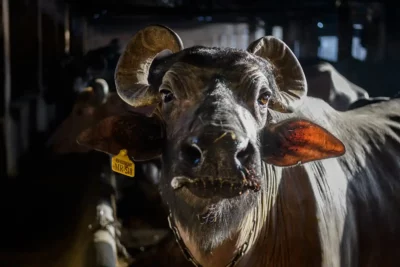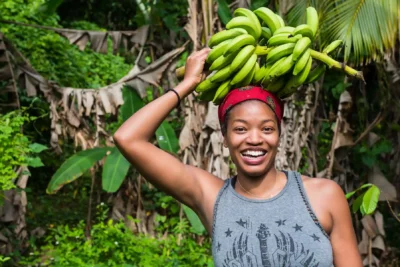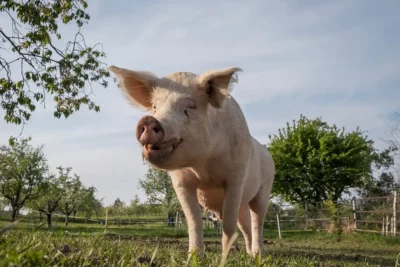By some estimates, Aarey Milk Colony has 16,000 milch buffaloes and a few cows. That number was shocking. I cannot even visualise what 16,000 people look like. And to imagine there are so many of them barely half an hour away from my home. I had to see how a forest could hold so many farmed animals.
On a crisp October morning, we set out to visit Aarey Milk Colony, situated in the quickly thinning Aarey forests of Mumbai. The forest known as the “lungs of Mumbai” is under threat from excessive construction around it creeping into it inch by inch. But a darker secret hides inside.
Anyone passing by the forest has seen long sheds often parallel to each other or at perpendicular angles with high walls and a slight opening at the very top which allows the smell of buffalo dung to permeate through the forest. No one sees the buffaloes, we just know they are there.
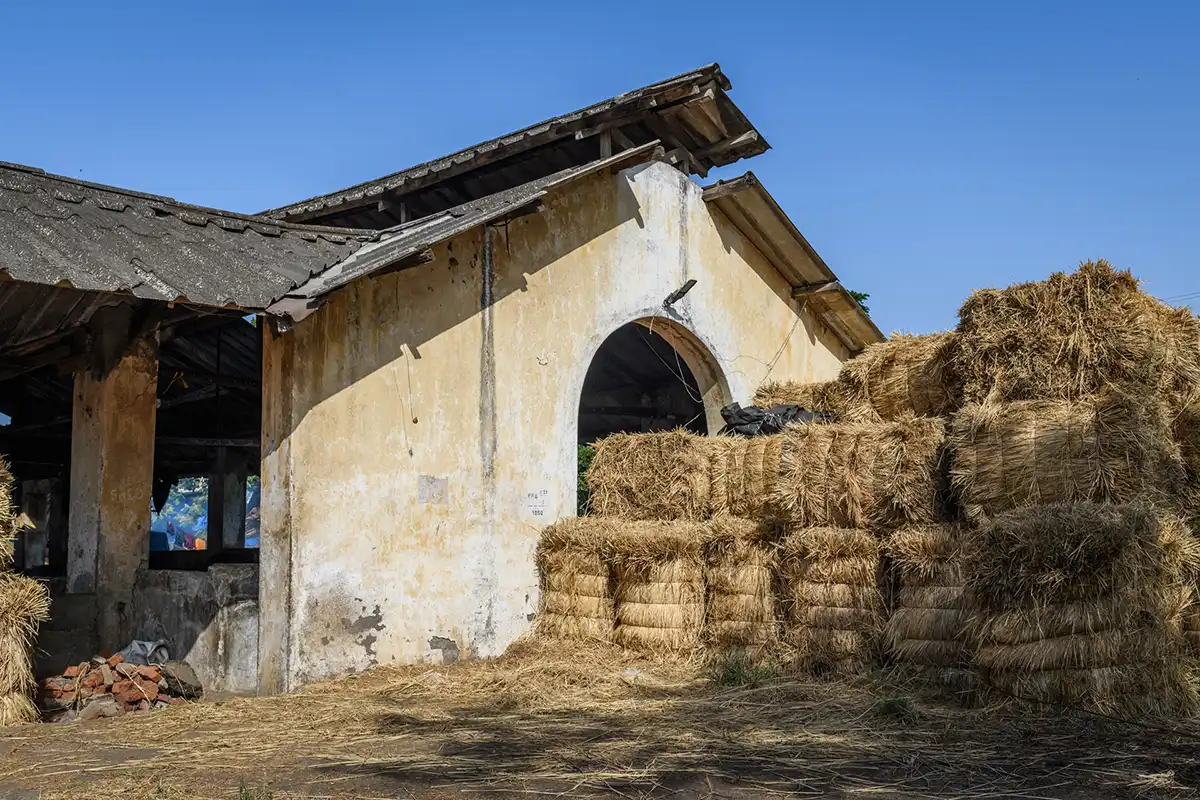
Growing up in Mumbai we all knew that the Aarey forest had dairy farms and it was called Aarey Milk Colony for a reason. The co-operative set up in the 1970s by the same people responsible for the White Revolution in India was formed for two main reasons among many others: to move the cows and buffaloes from the urban areas and to ensure the city of Mumbai has a steady supply of milk. Legally, 30 stables were allowed to be built in the colony that could house 500-550 animals. The forest is also home to many villages whose locals live there with their own milch animals and chickens.
When we entered the forest there was a definite drop in the temperature, as is the case with any densely forested area. The further in we went, the stronger the smell got, the ammonia and hydrogen sulphide together giving it the typical tabela stench.
We passed by a few stables until we decided to stop at one that had a person standing outside with a huge steel bucket and small plastic packets of milk from the buffaloes that was probably taken a few hours earlier. People passing by on foot were stopping to purchase this “fresh” milk oblivious to what was happening behind the walls of the stables.
It was close to 7 a.m. and the workers were busy with their morning chores, cleaning up the sheds with brooms, walking around with dry grass that was meant for the buffaloes, making chai, and checking on the animals.
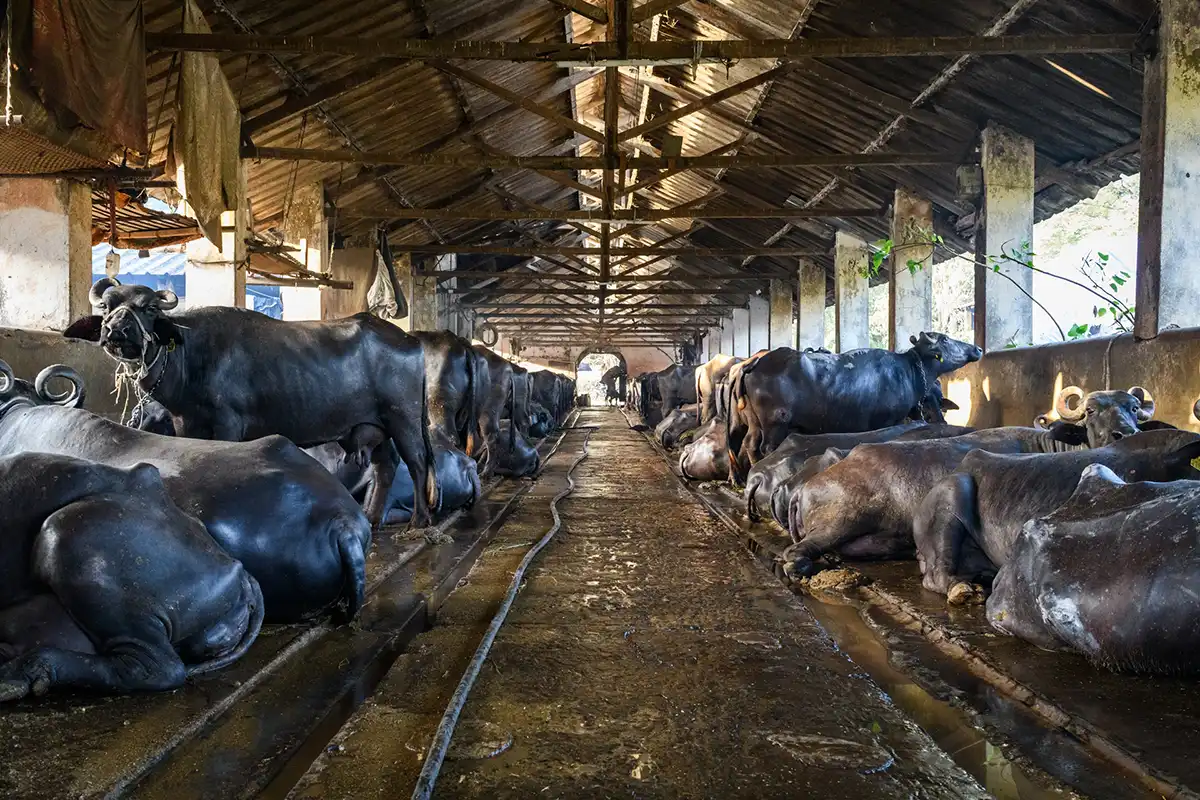
When we entered the first shed, the horror overtook everything else. A long passage in the middle with the backsides of 80-100 buffaloes on either side of the narrow walkway. The buffaloes all turned to look at us, curious and scared of our unknown faces. They were tied with very short ropes to face the walls while their tails flicked as we walked by. Just in front of them, one man was dropping bales of hay but they all stopped eating to look at us.
As vegans, we know the truth behind the production of dairy, but it never prepares you for when you have to look the animals in the eye and sense their fear and pain. We just tried not to show how sad it made us while also trying not to slip on the hard, wet cemented floor splattered with urine and dung.
All the buffaloes except one were female. The lone male bull, tied right at the beginning of the shed towered over the females but was the most scared of us. The saddest thing, however, was to see that there were about five or six female buffalo calves in that shed.
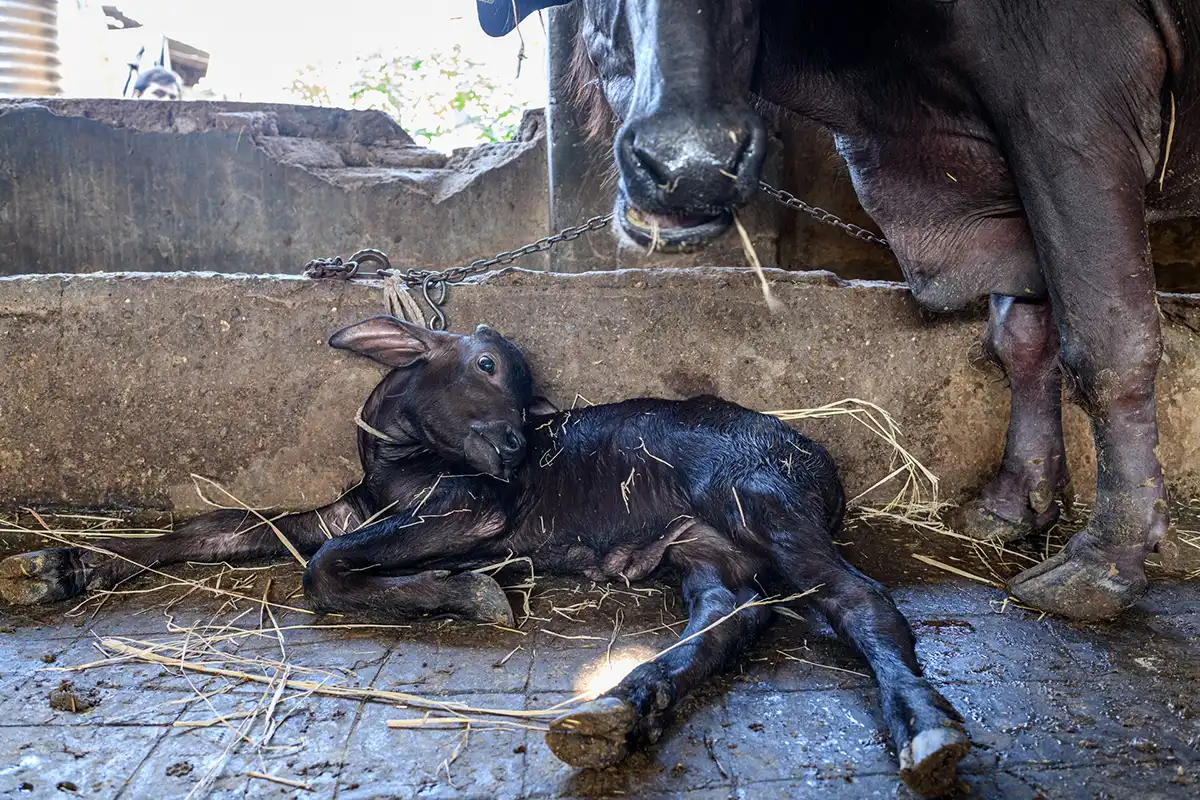
Just for a second imagine 100 female buffaloes, all producing milk. The only reason they would do that is for their young. So they were pregnant and they had their babies. But their babies were not there at this farm. Out of the six who were there, one was tied near her mother, probably because her mother would release milk only if her baby was around. The other five were kept away from their mothers and were calling continuously. They were equally scared of us but curious enough to let us approach them. The other sheds had slightly older calves tied up near pillars, just close enough to see their mothers, but far enough so they couldn’t touch them. One male calf at the farm was being starved until he passed. These are accepted practices at all dairy farms in India.
One of the workers was walking around the shed with a small bottle of paracetamol in his hand and a syringe in the other. He approached a buffalo and with a quick stab jabbed the syringe into her back and pressed it to release the medication. He did this a few more times to a few others refilling the syringe after every stab. They all had fever and he was medicating them for the fever. Another worker walked around with a much bigger syringe filled with oxycontin which was given at 11 am to the females producing less milk so that by the 4 pm milking round their bodies would be forced to produce more. He was no veterinarian, just a daily wage labourer who was doing what he was asked to.
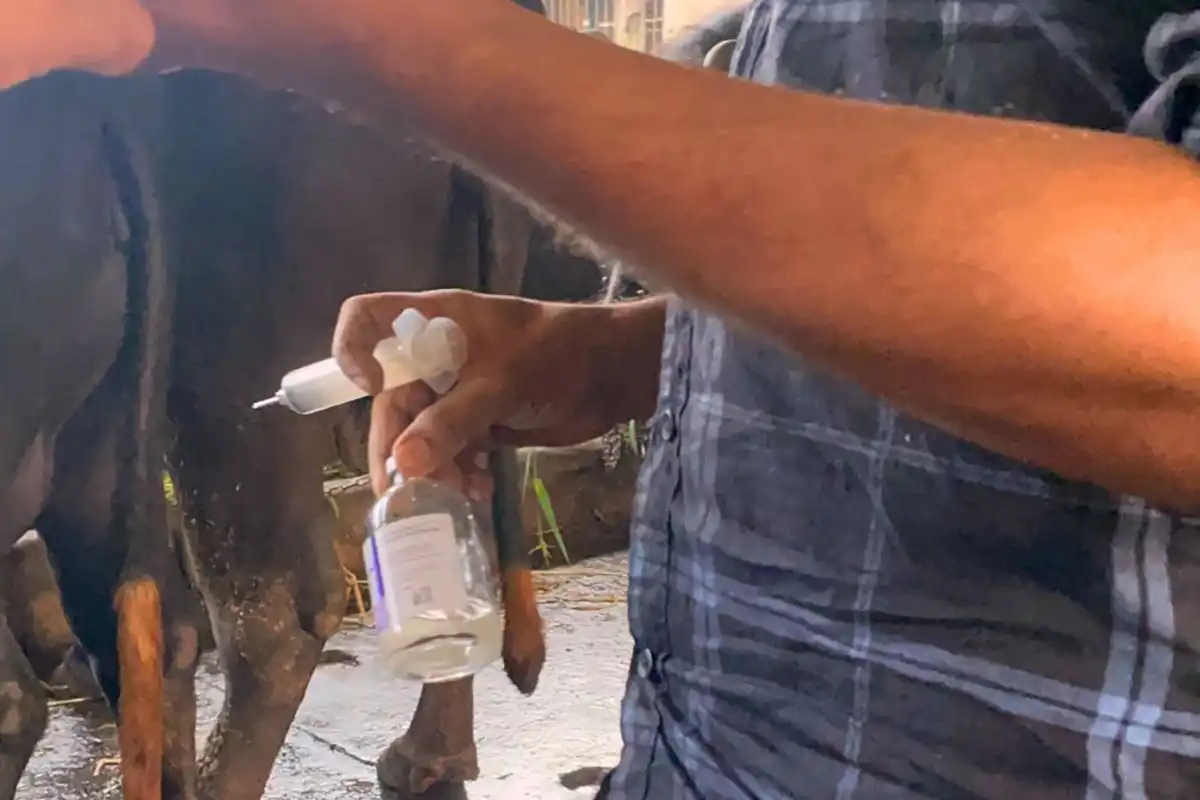
We took carrots along hoping to make friends with the animals. We asked him to help us with the carrots. But not even one of the 300 buffaloes we met would accept our friendship or his. They tried their best to move their bodies away from him as soon as he approached. The betrayal by humans was too strongly etched in their minds, they were not going to trust us even if we told them we meant no harm.
We walked further into this farm and saw 300 more buffaloes and about 10 more calves. The workers were hitting the buffaloes because that was the only way they would listen to them. Outside one of the sheds, a male buffalo was being forced to mount and impregnate the female. This constant cycle of violence was being borne by the animals, but it showed on the workers’ faces too.
Many of the workers were from outside the city and were working here because they were not suitable for any other job. Some were drunk, probably on alcohol, and most were chewing on tobacco to keep them going through the cycles of milking the animals which started as early as 3 am. They lived in those stables in small shanties with their coworkers earning a meagre ₹10,000 to ₹12,000 per month which was barely enough to cover their expenses and those of their families back home in the villages. Their salaries would be cut if they woke up late or took holidays. They were also stuck in the vicious cycle of dairy production, unwilling participants in the abuse facing nothing short of abuse themselves.
As we talked with them further, we learned that a truck comes in the cover of the night and takes the calves to slaughterhouses. We assumed they would keep the female calves and get rid of the males, but for every animal tied at the shed a fee is charged to the owner, so in order to keep the costs down, very few calves are retained. Most of these babies are packed off in the middle of the night and sent off without their mothers just a few hours after birth to be sold as “bobby veal”.
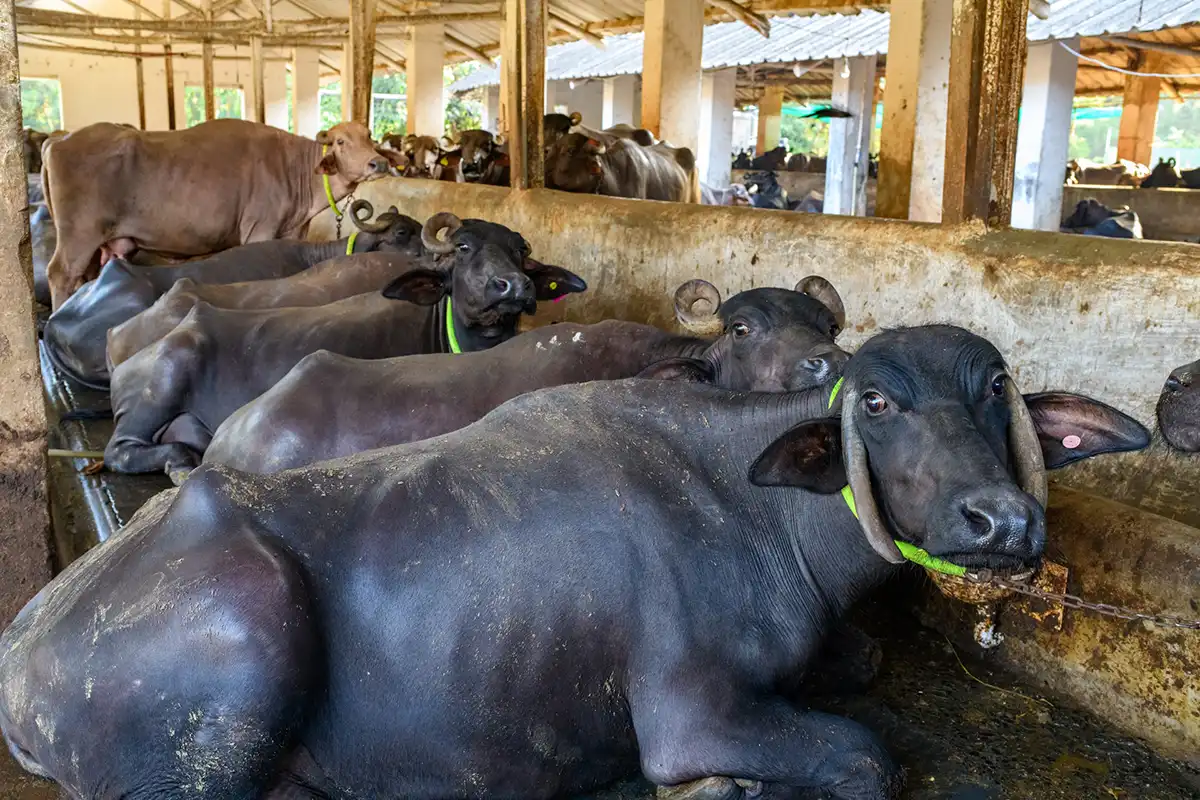
Most people visualise cows when they think of dairy products, but India has close to 110 million Asian water buffaloes who are quietly trapped in the dairy production system along with the cows. Why quietly? Because no one fights for their rights as much as they do for the holy cow and ALL the buffaloes from the dairy farms and the dairy industry end up getting slaughtered. Buffalo flesh is what is allowed to be sold as beef in many states in India where cow slaughter is banned. And this flesh is coming from the dairy industry. The flesh from buffaloes is known as ‘carabeef’, a word borrowed from Filipino English and is sold under that name.
Buffaloes supply 45 per cent of India’s milk and are an important part of the dairy sector in India. They are also an important part of India’s beef and veal exports which were valued at $3.19 billion in the fiscal year 2023. Accounted for in dollars and by weight, their flesh is but a by-product of the White Revolution. The dairy industry is the beef industry.
